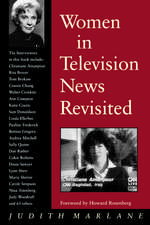The Aesthetics of Nostalgia TV: Production Design and the Boomer Era
Autor Alex Bevanen Limba Engleză Hardback – 6 feb 2019
| Toate formatele și edițiile | Preț | Express |
|---|---|---|
| Paperback (1) | 224.41 lei 6-8 săpt. | |
| Bloomsbury Publishing – 19 aug 2020 | 224.41 lei 6-8 săpt. | |
| Hardback (1) | 716.15 lei 6-8 săpt. | |
| Bloomsbury Publishing – 6 feb 2019 | 716.15 lei 6-8 săpt. |
Preț: 716.15 lei
Preț vechi: 1028.63 lei
-30% Nou
Puncte Express: 1074
Preț estimativ în valută:
137.03€ • 143.09$ • 113.16£
137.03€ • 143.09$ • 113.16£
Carte tipărită la comandă
Livrare economică 15-29 aprilie
Preluare comenzi: 021 569.72.76
Specificații
ISBN-13: 9781501331411
ISBN-10: 1501331418
Pagini: 264
Ilustrații: 29 bw illus
Dimensiuni: 152 x 229 mm
Greutate: 0.57 kg
Editura: Bloomsbury Publishing
Colecția Bloomsbury Academic
Locul publicării:New York, United States
ISBN-10: 1501331418
Pagini: 264
Ilustrații: 29 bw illus
Dimensiuni: 152 x 229 mm
Greutate: 0.57 kg
Editura: Bloomsbury Publishing
Colecția Bloomsbury Academic
Locul publicării:New York, United States
Caracteristici
Includes first-hand interviews with Janie Bryant (the costume designer for Mad Men) and Eduardo Castro (the costume designer for Ugly Betty), alongside set dressers, prop masters and production designers from Ugly Betty, Desperate Housewives, and Mad Men
Notă biografică
Alex Bevan is a Lecturer in Digital Media at the School of Communication and Arts at the University of Queensland in Brisbane, Australia. Her articles have appeared in Cinema Journal, Adaptation and Television and New Media.
Cuprins
Acknowledgements PrefaceIntroduction: Touring the Mad Men SetInterventions in Production Studies Devising Authorship Deconstructing the "Text"Methodological Interventions Interventions in Memory Studies Quality Television and Identity Politics Chapter BreakdownPart I: SetsChapter One: TV Suburbia and Remembering the Sitcom Set Introduction: The Nostalgia of Recycled SetsThe Sitcom Studio Lot as Living ArchiveMy Universal Studio Tour and Narrativizing Fantastic Space Conclusion: Industry Nostalgia and the Sitcom HomeChapter Two: Office Sets and Nostalgic Modernism in the TV Workplace Introduction: Differences at WorkWhat the Modernist Office Set Says About Fantasies of Self and Home The Politics of Taste in Television Production Design's Reinventions of Modernism"Bad Taste" and Gender Identity in the Corporate Modernist Set The Industry Background of Reinventing the Boomer Years Conclusion: Retro Modernism as ShorthandPart II: PropsChapter Three: Prop Talk: A Behind the Scenes Look Introduction: The Importance of PropsPress About PropsThe Popular Legitimation of the Prop Industry and Digital Tensions When Props Become the Whole Story: Historical Time Travel Conclusion: Digital Era Prop TalkChapter Four: Prop Stories: Media Props in Narrative Context Introduction: Props Tell StoriesThe Polaroid as Narrative DeviceThe Home Movie as Historical ConduitThe Nostalgic Anticipation of Digitality in Mad Men Old Media Props in Other Period Dramas Conclusion: The Privileges of Time TravelPart III: CostumesChapter Five: Making, Renting, and Telling Histories Through Costume Introduction: Clothes Tell StoriesCostume Design as Gender Historian Telling History By DisrobingFrom the Maker's PerspectiveOther Examples of Television Fashion Doing Gender History Conclusion: When Words Fails, Costumes Do NotChapter Six: Costume Countermemory: Marginalized Television Voices and Chicana RetroIntroduction: Questioning Nostalgia's Whiteness The Postwar "New Look" and Nostalgia TVUgly Betty's Aesthetic, Narrative, and Industrial Diaspora Clashing Vintage Patterns and "Bad" TasteThe Western Costume Company and Costume Bricolage Bad Taste in Nostalgic Costume DesignConclusion: How Far We've Come?Conclusion: Nostalgic FailureWhen Nostalgia Goes Bad: The Playboy Club, Aquarius, and Pam AmDraper Fatigue Nostalgia in 3DBibliography Index
Recenzii
When Bevan hits her critical stride the results can be fascinating, and her understanding of nostalgia as a multilayered and often contradictory cultural phenomenon is often exemplary.
An important addition to the field . offers a compelling assessment of a long-overlooked facet in understanding nostalgia inducing television shows.
Nostalgia, Alex Bevan demonstrates, is a material practice that brings the past into the present and vice versa, in ways that are complex, contradictory, and deeply political. The Aesthetics of Nostalgia TV takes us on a wide-ranging tour of the materiality of contemporary television and how particular practices evoke, remake, and comment upon the past, be it through the recycling of sets in Desperate Housewives, the modernist furniture of Ugly Betty, or the shape and style of ice cubes, flatware, and shirt-dresses in Mad Men. Expertly weaving together fashion, design, and architectural history with interviews of those who supply the below-the-line labor of television's production, set, and costume design, The Aesthetics of Nostalgia TV expands and reimagines the possibilities of television criticism.
With its attention to "below the line" creativity, intergenerational modalities and the unstable nostalgia that governs so many representations of baby boomer culture, this book travels down many productive paths. In so doing, it offers an exceptionally holistic account of US television.
Aesthetics of Nostalgia TV: Production Design and the Boomer Era is a marvelous accomplishment as a theoretical intervention making a powerful case for production design and art direction's pivotal role in contemporary television drama's aesthetic and story-telling practices. It is also a significant extension of production studies to the pivotal creative work of those involved in staging production through props, costuming, and architectural settings. Bevan usefully and artfully shows just how fruitful the exchange has been between architecture and production design with sets becoming less like theatrical spaces and more like real built environments as producers have turned to improvements in production design to provide compelling television. Part genre study of nostalgia TV and part case study of the central role played by production design and designers more generally, Bevan expertly weaves together the central role played not only by props, costumes and built sets but by the businesses and creative workers who work with these to the overall shape, power, cultural resonance, of television series production.
An important addition to the field . offers a compelling assessment of a long-overlooked facet in understanding nostalgia inducing television shows.
Nostalgia, Alex Bevan demonstrates, is a material practice that brings the past into the present and vice versa, in ways that are complex, contradictory, and deeply political. The Aesthetics of Nostalgia TV takes us on a wide-ranging tour of the materiality of contemporary television and how particular practices evoke, remake, and comment upon the past, be it through the recycling of sets in Desperate Housewives, the modernist furniture of Ugly Betty, or the shape and style of ice cubes, flatware, and shirt-dresses in Mad Men. Expertly weaving together fashion, design, and architectural history with interviews of those who supply the below-the-line labor of television's production, set, and costume design, The Aesthetics of Nostalgia TV expands and reimagines the possibilities of television criticism.
With its attention to "below the line" creativity, intergenerational modalities and the unstable nostalgia that governs so many representations of baby boomer culture, this book travels down many productive paths. In so doing, it offers an exceptionally holistic account of US television.
Aesthetics of Nostalgia TV: Production Design and the Boomer Era is a marvelous accomplishment as a theoretical intervention making a powerful case for production design and art direction's pivotal role in contemporary television drama's aesthetic and story-telling practices. It is also a significant extension of production studies to the pivotal creative work of those involved in staging production through props, costuming, and architectural settings. Bevan usefully and artfully shows just how fruitful the exchange has been between architecture and production design with sets becoming less like theatrical spaces and more like real built environments as producers have turned to improvements in production design to provide compelling television. Part genre study of nostalgia TV and part case study of the central role played by production design and designers more generally, Bevan expertly weaves together the central role played not only by props, costumes and built sets but by the businesses and creative workers who work with these to the overall shape, power, cultural resonance, of television series production.























